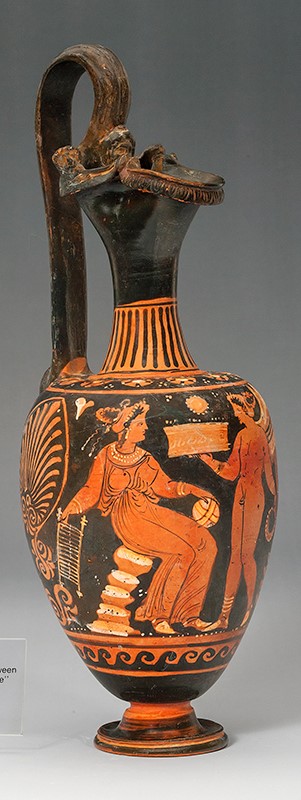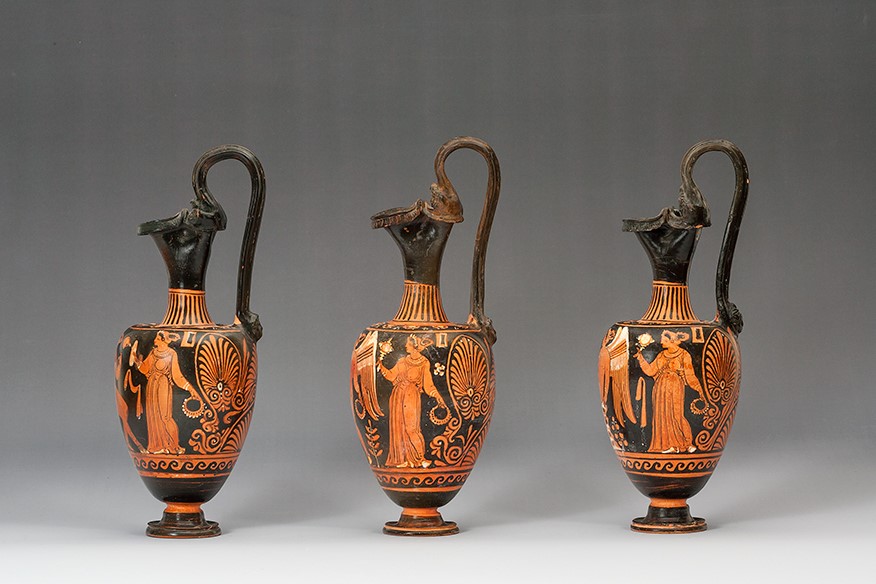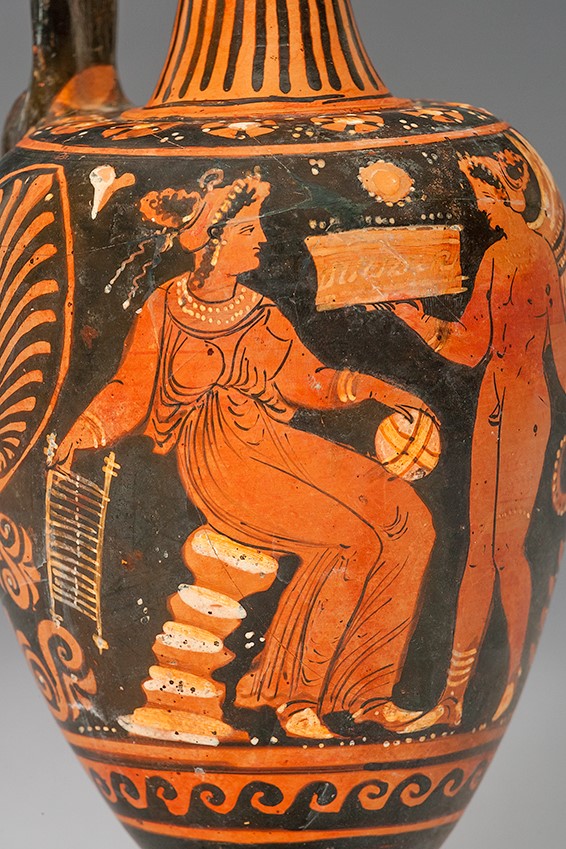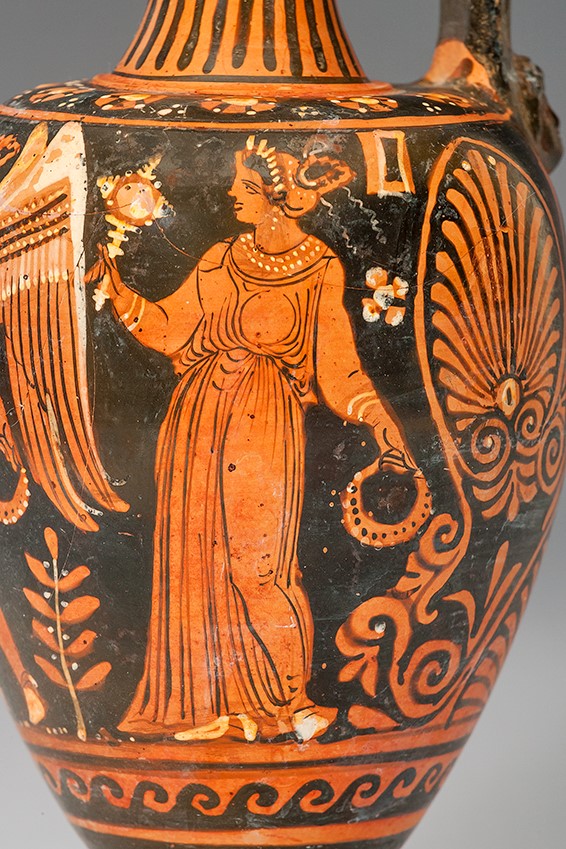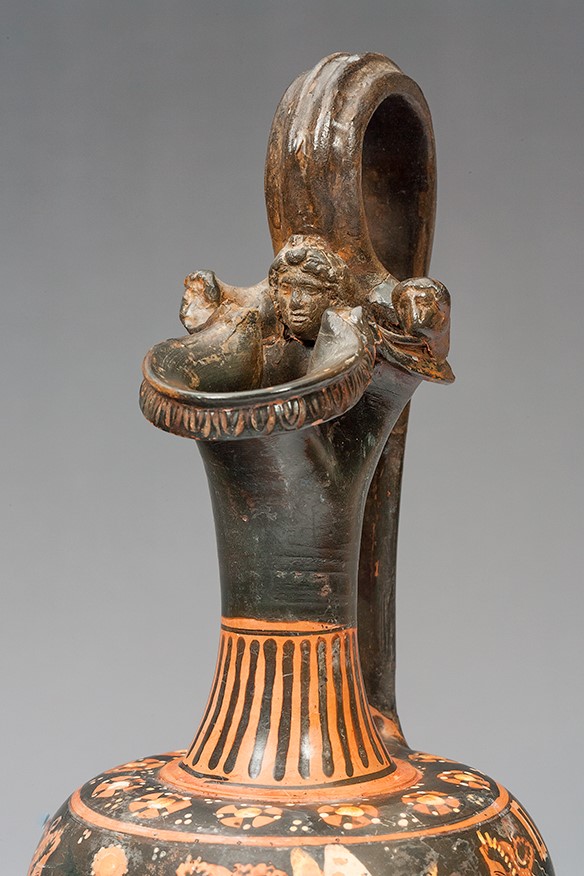Acquisition number: 1965.20
Oinochoe (shape 1). On the body is an Eros standing between a seated woman and a standing woman. The seated woman holds a ‘xylophone’ in her right hand and with her left supports a ball on her knee. Eros, standing facing left, holds a box or basket in his right hand and a wreath in his left. The standing woman also holds a wreath in her left hand but has a mirror in her right. The added yellow-white is less well preserved on this vase, but the Eros has the same stephane, earring, double necklace, bangles and string of beads around his left thigh as well as the bangle around his ankle and the slippers.
Title: Oinochoe (shape 1) - 1965.20
Acquisition number: 1965.20
Attribution: Menzies Painter.
Author or editor: J.R. Green
Culture or period: West Greek.
Date: c. 340 - 320 BC.
Material: Clay - Terracotta
Object type: Vessels - Jug/wine jug
Dimensions: 101mm (w) × 278mm (h)
Origin region or location: Italy
Origin city: Altamura.
Display case or on loan: 8
Keywords: Apulian, Red Figure, Apulian Tomb Group, Menzies Painter, Eros
J.R. Green with B. Rawson, Catalogue of Antiquities in the Australian National University, A.N.U. (Canberra, 1981) 52-53; A.D. Trendall and A. Cambitoglou, The Red-Figured Vases of Apulia, ii (Oxford 1982) 826 no. 89, pl. 311, 2; A.D. Trendall, The Red Figure Vases of South Italy and Sicily. A Handbook (London 1989) ill. 244.
1965.20
Oinochoe (shape 1)
Ht incl. handle 27.8cm; ht (lip) 23.4cm; diam. 10.1cm.
The potterwork and the subsidiary decoration are the same as 1965.19 save that female heads like those of 1965.21 are substituted for those of the Amazons as appliqués at the top and bottom of the handle.
On the body is an Eros standing between a seated woman and a standing woman. The seated woman holds a ‘xylophone’ in her right hand and with her left supports a ball on her knee. Eros, standing facing left, holds a box or basket in his right hand and a wreath in his left. The standing woman also holds a wreath in her left hand but has a mirror in her right. The added yellow-white is less well preserved on this vase, but the Eros has the same stephane, earring, double necklace, bangles and string of beads around his left thigh as well as the bangle around his ankle and the slippers.
Compare 1965.19 by the Menzies Painter (in this catalogue). The ‘xylophone’ or ladder-like object held by the seated woman has been the subject of continued debate since the 19th century: see for example the survey of views presented by H. Heydemann, “De scalae in vasorum picturis significatu”, Annali dell’Instituto 4 (1869) 309-320 (available through archive.org). A fundamental discussion, where references to earlier literature will be found, is that by G. Schneider-Herrmann, “Das Xylophon in der Vasenmalerei Sud-Italiens”, Festoen. Opgedragen aan A.N. Zadoks-Josephus Jitta (Groningen 1976) 517-526, with addenda in Bulletin Antieke Beschaving 52-53, 1977-78, 265-278; also E. Keuls, “The Apulian Xylophone”, American Journal of Archaeology 83, 1979, 476-77; M. Jentoft-Nilsen, “More Xylophones”, Bulletin Antieke Beschaving 55, 1980, 247; Trendall and Cambitoglou, A.D. Trendall and A. Cambitoglou, The Red-Figured Vases of Apulia, i (Oxford 1978) 315-316; J. Nelson, “‘Xylophones’ on Gnathia Vases”, Bulletin Antieke Beschaving 61, 1986, 30-33; G. Salapata, “The ‘Apulian Sistrum’. Monotone or ‘Melodic’?”, in: E. Hickmann, A.D. Kilmer and R. Echmann (eds), Studien zur Musikarchäologie III (Rahden/Westf. 2002) 415-428; A. Zschätzsch, “Ein Musikinstrument der Aphrodite?”, Die Musikforschung 56:2, 2003, 135-154 (she includes a list of surviving exanples of the instrument as well as a [necessaril incomplete] list of representations). F. Vergara Cerqueira, “Iconographical Representations of Musical Instruments in Apulian Vase-Painting as Ethnical Signs: Intercultural Greek-Indigenous Relations in Magna Graecia (5th and 4th Centuries B.C.)”, Greek and Roman Musical Studies 2, 2014, 50-67 discusses a fuller selection of instruments. A readily accessible example of the object may be found in Archaeological Reports 1976-77, 59 fig. 20. It was a ritual musical instrument used by women. Another example is depicted on the kantharos 1965.29.
For the box or basket carried by the Eros for the woman on the left, compare 1965.19 and the comments there.
J.R. Green with B. Rawson, Catalogue of Antiquities in the Australian National University, A.N.U. (Canberra, 1981) 52-53; A.D. Trendall and A. Cambitoglou, The Red-Figured Vases of Apulia, ii (Oxford 1982) 826 no. 89, pl. 311, 2; A.D. Trendall, The Red Figure Vases of South Italy and Sicily. A Handbook (London 1989) ill. 244.
Australian National University.
